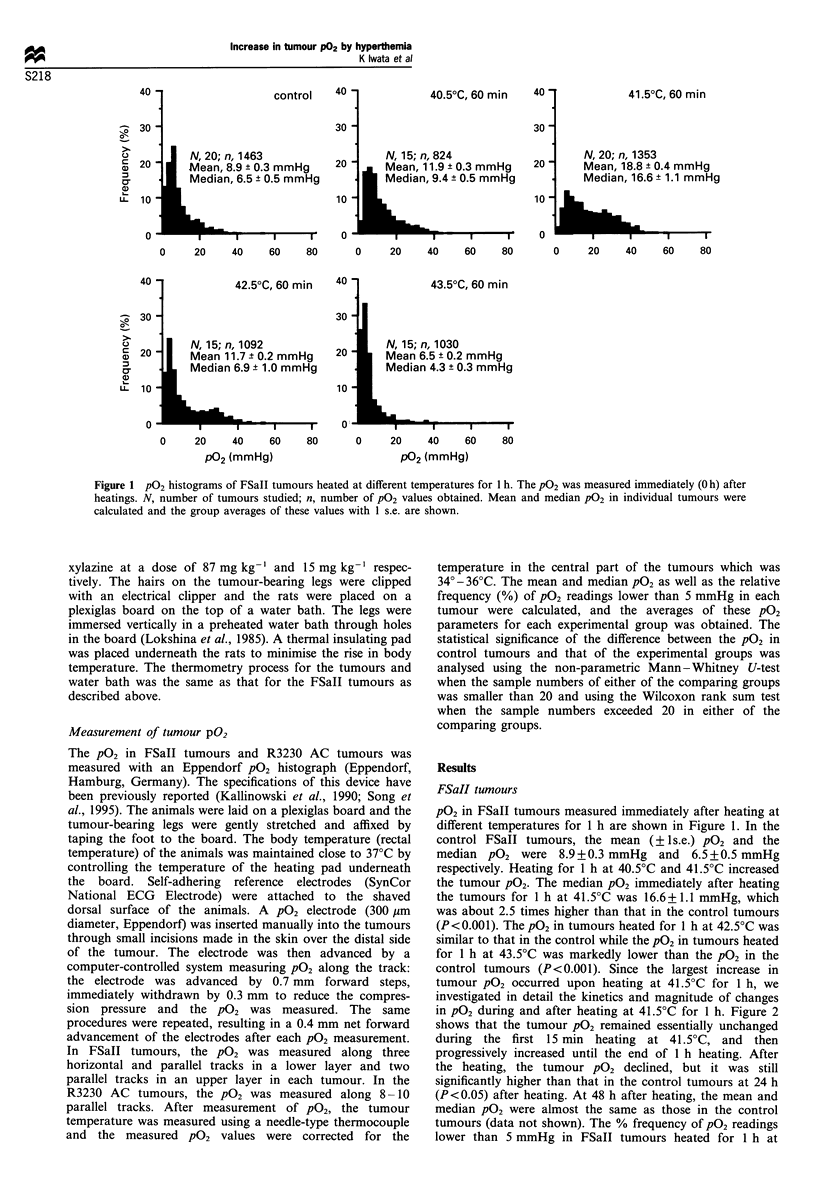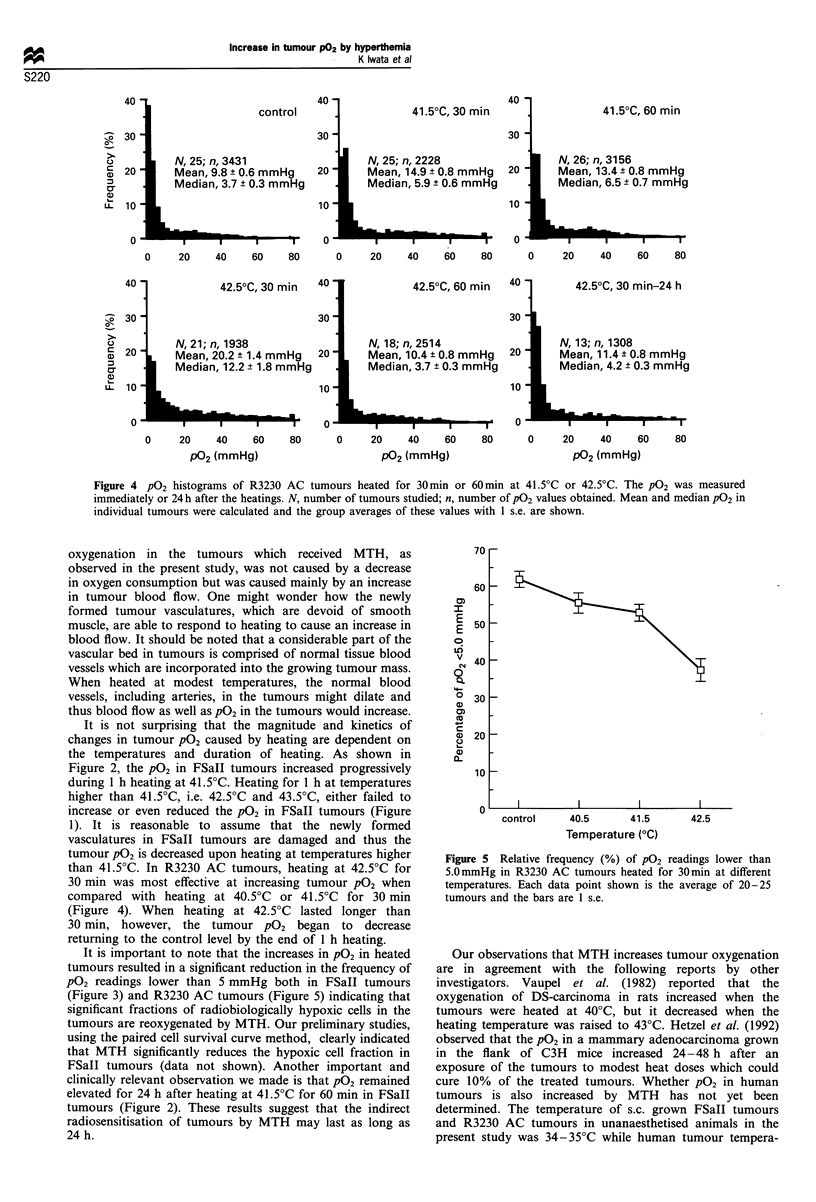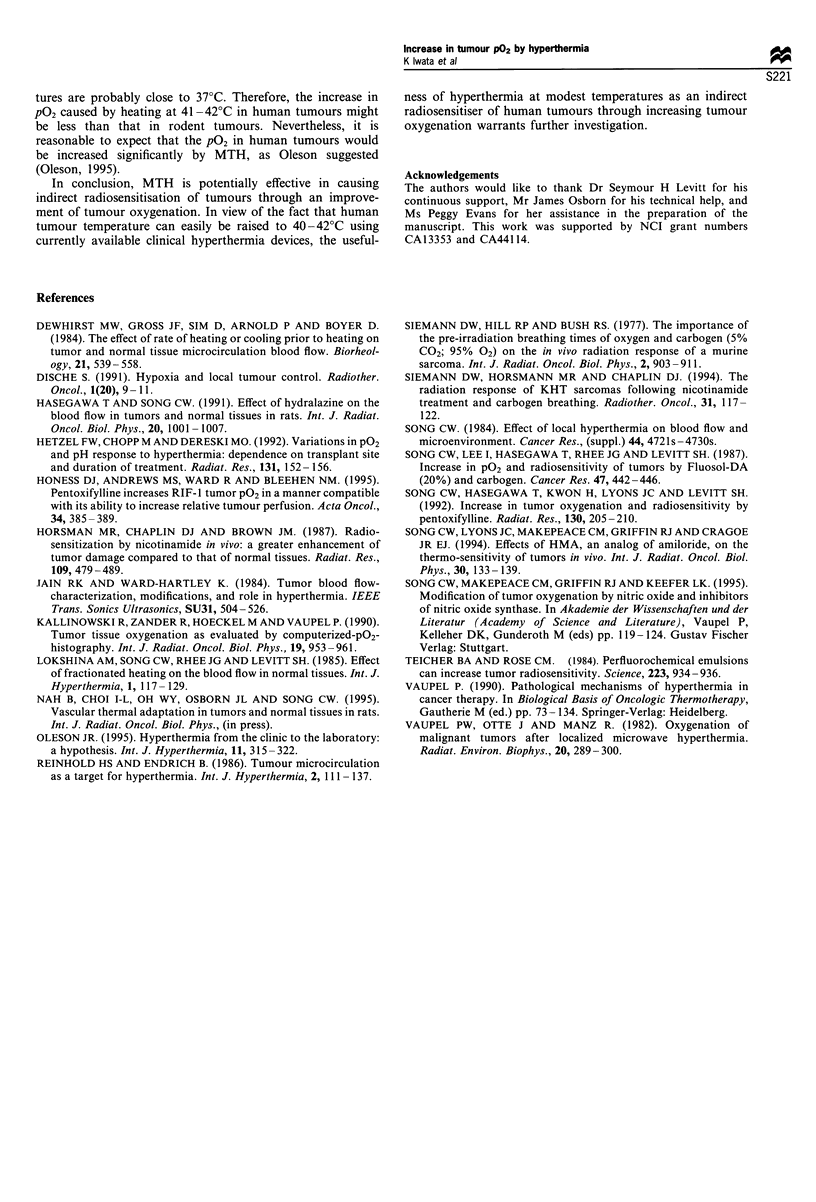Abstract
We have studied the feasibility of improving tumour oxygenation with hyperthermia at modest temperatures which are achievable with the use of presently available clinical hyperthermia machines. FSaII tumours grown s.c. in the leg of C3H mice and R3230 AC tumours grown s.c. in the leg of Fischer rats were heated with a water bath and the tumour pO2 was determined with an Eppendorf pO2 histograph. The median pO2 in 7-8 mm diameter control FSaII tumours was 6.5 +/- 0.5 mmHg and it increased to 16.6 +/- 1.1 mmHg when the tumours were heated at 41.5 degrees C for 1 h. The median pO2 in 10 mm diameter control R3230 AC tumours was 3.7 +/- 0.3 mmHg. Heating at 42.5 degrees C for 30 min increased the median pO2 in the R3230 AC tumours to 12.2 +/- 1.8 mmHg. The pO2 in FSaII tumours measured 24 h after heating at 41.5 degrees C for 1 h was still higher than the pO2 before heating. The % frequency of pO2 values lower than 5 mmHg decreased markedly when the tumours were heated at the modest temperatures mentioned above. Modest temperature hyperthermia (MTH) may be an efficient and useful means to improve the oxygenation of human tumours.
Full text
PDF




Selected References
These references are in PubMed. This may not be the complete list of references from this article.
- Dewhirst M., Gross J. F., Sim D., Arnold P., Boyer D. The effect of rate of heating or cooling prior to heating on tumor and normal tissue microcirculatory blood flow. Biorheology. 1984;21(4):539–558. doi: 10.3233/bir-1984-21413. [DOI] [PubMed] [Google Scholar]
- Dische S. Hypoxia and local tumour control. Part 2. Radiother Oncol. 1991;20 (Suppl 1):9–11. doi: 10.1016/0167-8140(91)90180-o. [DOI] [PubMed] [Google Scholar]
- Hasegawa T., Song C. W. Effect of hydralazine on the blood flow in tumors and normal tissues in rats. Int J Radiat Oncol Biol Phys. 1991 May;20(5):1001–1007. doi: 10.1016/0360-3016(91)90197-c. [DOI] [PubMed] [Google Scholar]
- Hetzel F. W., Chopp M., Dereski M. O. Variations in pO2 and pH response to hyperthermia: dependence on transplant site and duration of treatment. Radiat Res. 1992 Aug;131(2):152–156. [PubMed] [Google Scholar]
- Honess D. J., Andrews M. S., Ward R., Bleehen N. M. Pentoxifylline increases RIF-1 tumour pO2 in a manner compatible with its ability to increase relative tumour perfusion. Acta Oncol. 1995;34(3):385–389. doi: 10.3109/02841869509093994. [DOI] [PubMed] [Google Scholar]
- Horsman M. R., Chaplin D. J., Brown J. M. Radiosensitization by nicotinamide in vivo: a greater enhancement of tumor damage compared to that of normal tissues. Radiat Res. 1987 Mar;109(3):479–489. [PubMed] [Google Scholar]
- Kallinowski F., Zander R., Hoeckel M., Vaupel P. Tumor tissue oxygenation as evaluated by computerized-pO2-histography. Int J Radiat Oncol Biol Phys. 1990 Oct;19(4):953–961. doi: 10.1016/0360-3016(90)90018-f. [DOI] [PubMed] [Google Scholar]
- Lokshina A. M., Song C. W., Rhee J. G., Levitt S. H. Effect of fractionated heating on the blood flow in normal tissues. Int J Hyperthermia. 1985 Apr-Jun;1(2):117–129. doi: 10.3109/02656738509029279. [DOI] [PubMed] [Google Scholar]
- Oleson J. R. Eugene Robertson Special Lecture. Hyperthermia from the clinic to the laboratory: a hypothesis. Int J Hyperthermia. 1995 May-Jun;11(3):315–322. doi: 10.3109/02656739509022467. [DOI] [PubMed] [Google Scholar]
- Reinhold H. S., Endrich B. Tumour microcirculation as a target for hyperthermia. Int J Hyperthermia. 1986 Apr-Jun;2(2):111–137. doi: 10.3109/02656738609012389. [DOI] [PubMed] [Google Scholar]
- Siemann D. W., Hill R. P., Bush R. S. The importance of the pre-irradiation breathing times of oxygen and carbogen (5% CO2: 95% O2) on the in vivo radiation response of a murine sarcoma. Int J Radiat Oncol Biol Phys. 1977 Sep-Oct;2(9-10):903–911. doi: 10.1016/0360-3016(77)90188-2. [DOI] [PubMed] [Google Scholar]
- Siemann D. W., Horsman M. R., Chaplin D. J. The radiation response of KHT sarcomas following nicotinamide treatment and carbogen breathing. Radiother Oncol. 1994 May;31(2):117–122. doi: 10.1016/0167-8140(94)90391-3. [DOI] [PubMed] [Google Scholar]
- Song C. W. Effect of local hyperthermia on blood flow and microenvironment: a review. Cancer Res. 1984 Oct;44(10 Suppl):4721s–4730s. [PubMed] [Google Scholar]
- Song C. W., Hasegawa T., Kwon H. C., Lyons J. C., Levitt S. H. Increase in tumor oxygenation and radiosensitivity caused by pentoxifylline. Radiat Res. 1992 May;130(2):205–210. [PubMed] [Google Scholar]
- Song C. W., Lee I., Hasegawa T., Rhee J. G., Levitt S. H. Increase in pO2 and radiosensitivity of tumors by Fluosol-DA (20%) and carbogen. Cancer Res. 1987 Jan 15;47(2):442–446. [PubMed] [Google Scholar]
- Song C. W., Lyons J. C., Makepeace C. M., Griffin R. J., Cragoe E. J., Jr Effects of HMA, an analog of amiloride, on the thermosensitivity of tumors in vivo. Int J Radiat Oncol Biol Phys. 1994 Aug 30;30(1):133–139. doi: 10.1016/0360-3016(94)90528-2. [DOI] [PubMed] [Google Scholar]
- Teicher B. A., Rose C. M. Perfluorochemical emulsions can increase tumor radiosensitivity. Science. 1984 Mar 2;223(4639):934–936. doi: 10.1126/science.6695191. [DOI] [PubMed] [Google Scholar]
- Vaupel P. W., Otte J., Manz R. Oxygenation of malignant tumors after localized microwave hyperthermia. Radiat Environ Biophys. 1982;20(4):289–300. doi: 10.1007/BF01323754. [DOI] [PubMed] [Google Scholar]


